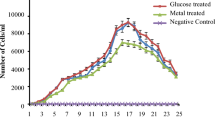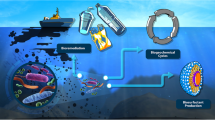Abstract
Two strains of bacteria were isolated from deep-ocean sediments of the South China Sea using enrichment culturing technique and they were identified as Sphingomonas yanoikuyae DOS01 (AY878409) and Variovorax paradoxus T4 (AY878410) based on 16S rRNA gene sequences. S. yanoikuyae DOS01 was only capable of transforming dimethyl terephthalate (DMTP) to monomethyl terephthalate (MMTP) without further degradation while V. paradoxus T4 exhibited ability in mineralizing DMTP as the sole source of carbon and energy. The biochemical pathway of DMTP degradation was through MMTP and terephthalic acid (TA) as major detectable degradation intermediates in the culture media by both microorganisms. V. paradoxus T4 utilized DMTP and MMTP via hydrolysis of diester and monoester in the initial steps in degradation as confirmed by total organic carbon analysis of the culture medium and esterase activity assay of the lysed cells and fraction. The specific hydrolysis activity of esterase induced by DMTP or MMTP showed that greater hydrolysis of p-nitrophenyl acetate by esterase induced by DMTP-grown cells than that induced by MMTP. Results of this research suggest that the cleavage of the two identical carboxylic ester groups of phthalate diester are carried out by highly specific esterases of the same bacteria in the environment.



Similar content being viewed by others
References
Allison N, Turner JE, Wait R (1995) Degradation of homovanillate by a strain of Variovorax paradoxus via ring hydroxylation. FEMS Microbiol Lett 134:213–219
Bradford MM (1976) A rapid and sensitive method for the quantitation of microgram quantities of protein utilizing the principle of protein-dye binding. Anal Chem 72:248–254
Cartwright CD, Owen SA, Thompson IP, Burns RG (2000) Biodegradation of diethyl phthalate in soil by a novel pathway. FEMS Microbiol Lett 186:27–34
Cheung KH ,Gu J-D (2005) Reduction of chromate (CrO4 2−) by a Bacillus magnetarium isolated from marine. World J Microbiol Biotechnol 21:213–219
Di Cello F, Bevivino A, Chiarini L, Fani R, Paffetti D, Tabacchioni S, Dalmastri C (1997) Biodiversity of a Burkholderia cepacia population isolated from the maize rhizosphere at different plant growth stages. Appl Environ Microbiol 63:4485–4493
Faber K (2004) Biotransformations in organic chemistry (5th edn.). Springer, New York
Fan Y, Wang Y, Qian P, Gu J-D (2004) Optimization of phthalic acid batch biodegradation and the use of modified Richards model for modeling degradation. Int Biodeterior Biodegradation 53:57–63
Giam CS, Chan HS, Neff GS, Atlas EL (1978) Phthalate ester plasticizers—new class of marine pollutant. Science 199:419–421
Goud HD, Parekh LJ, Ramakrishnan CV (1990) Treatment of DMT (Dimethyl terephthalate) industry waste water using mixed culture of bacteria and evaluation of treatment. J Environ Biol 11:15–26
Gryglewicz S (2003) Lipase catalysed synthesis of sebacic and phthalic esters. Enzyme Microbial Technol 33:952–957
Gu J-D, Li J, Wang Y (2004) Degradation of the endocrine-disrupting dimethyl phthalate ester isomers by aerobic microorganisms isolated from mangrove sediment. In: Verstraete W (ed) European symposium on environmental biotechnology, ESEB 2004. A.A. Balkema Publishers, London, pp 557–561
Gu J-D, Li J, Wang Y (2005) Biochemical pathway and degradation of phthalate ester isomers by bacteria. Water Sci Technol 52(8):241–248
Jackson MA, Labeda DP, Becker LA (1996) Isolation for bacteria and fungi for the hydrolysis of phthalate and terephthalate esters. J Ind Microbiol 16:301–304
Juneson C, Ward OP, Singh A (2002) Biodegradation of dimethyl phthalate with high removal rates in a packed-bed reactor. World J Microbiol Biotechnol 18:7–10
Kim E, Aversano P, Romine M, Schneider R, Zylstra G (1996) Homology between genes for aromatic hydrocarbon degradation in surface and deep-subsurface Sphingomonas strains. Appl Environ Microbiol 62:1467–1470
Kim E, Zylstra GJ, Freeman JP, Heinze TM, Deck J, Cerniglia CE (1997) Evidence for the role of 2-hydroxychromene-2-carboxylate isomerase in the degradation of anthracene by Sphingomonas yanoikuyae B1. FEMS Microbiol Lett 153:479–484
Kleerebezem R, Pol LWH, Lettinga G (1999a) Anaerobic degradation of phthalate isomers by methanogenic consortia. Appl Environ Microbiol 65:1152–1160
Kleerebezem R, Pol LWH, Lettinga G (1999b) Energetics of product formation during anaerobic degradation of phthalate isomers and benzoate. FEMS Microbiol Ecol 29:273–282
Kleerebezem R, Pol LWH, Lettinga G (1999c) The role of benzoate in anaerobic degradation of terephthalate. Appl Environ Microbiol 65:1161–1167
Krasavage WJ, Yanno FJ, Terhaar CJ (1973) Dimethyl terephthalate (DMT): acute toxicity, subacute feeding and inhalation studies in male rats. Am Ind Hyg Assoc J 34:455–462
Li J, Gu J-D, Pan L (2005a) Transformation of dimethyl phthalate, dimethyl isophthalate and dimethyl terephthalate by Rhodococcus rubber Sa and modeling the processes using the modified Gompertz model. Int Biodeterior Biodegradation 55:223–232
Li J, Gu J-D, Yao J-H (2005b) Degradation of dimethyl terephthalate by Pasteurella multocida Sa and Sphingomonas paucimobilis Sy isolated from mangrove sediment. Int Biodeterior Biodegradation 56:158–165
Li J, Gu J-D (2006) Biodegradation of dimethyl terephthalate by Pasteurella multocida Sa follows a alternative biochemical pathway. Ecotoxicology 15:391–397
Maskow T, Babel W (2001) A calorimetrically based method to convert toxic compounds into poly-3-hydroxybutyrate and to determine the efficiency and velocity of conversion. Appl Microbiol Biotechnol 55:234–238
Mahood IK, Hallmark N, McKinnell C, Walker M, Fisher JS, Sharpe RM (2005) Abnormal leydig cell aggregation in the fetal testis of rats exposed to di(n-butyl) phthalate and its possible role in testicular dysgenesis. Endocrinology 146:613–623
Meghji K, Ward OP, Araujo A (1990) Production, purification, and properties of extracellular carboxyl esterase from Bacillus subtilis NRRL 365. Appl Environ Microbiol 56:3735–3740
Monarca S, Pool-Zobel BL, Rizzi R, Klein P, Schmezer P, Piatti E, Pasquini R, De Fusco R, Biscardi D (1991) In vitro genotoxicity of dimethyl terephthalate. Mutation Res Lett 262:85–92
Neilson JW, Josephson KL, Pepper I, Arnold RB, Di Giovanni GD, Sinclair NA (1994) Frequency of horizontal gene transfer of a large catabolic plasmid (pJP4) in soil. Appl Environ Microbiol 60:4053–4058
Peterson JC, Freeman DH (1982) Phthalate ester concentration variations in dated sediment cores from Chesapeake Bay. Environ Sci Technol 16:464–469
Rahman MA, Muneer M, Bahnemann D (2003) Photocatalytic degradation of dimethyl terephthalate in aqueous suspensions of titanium dioxide. Res Chem Intermediates 29:35–50
Resnick S, Gibson D (1996) Oxidation of 6,7-dihydro-5H-benzocycloheptene by bacterial strains expressing naphthalene dioxygenase, biphenyl dioxygenase, and toluene dioxygenase yields homochiral monol or cis-diol enantiomers as major products. Appl Environ Microbiol 62:1364–1368
Shah SS, Desai JD, Ramakrishna C, Bhatt NM (1998) Aerobic biotreatment of wastewater from dimethyl terephthalate plant using biomass support particles. J Ferment Bioeng 86:215–219
Sivamurthy K, Wwamy BM, Pujar BG (1991) Transformatin of dimethylterephthalate by the fungus Sclerotium rolfsii. FEMS Microbiol Lett 79:37–40
Snellinx Z, Taghavi S, Vangronsveld J., van der Lelie D (2003) Microbial consortia that degrade 2,4-DNT by interspecies metabolism: isolation and characterisation. Biodegradation 14:19–29
Tserovska L, Dimkov R (2002) Dimethylterephthalate catabolism by Pseudomonas sp. J Cult Collections 3:33–37
Wang RF, Cao WW, Cerniglia CE (1996) PCR detection and quantitation of predominant anaerobic bacteria in human and animal fecal samples. Appl Environ Microbiol 62:1242–1247
Wang Y, Gu J-D (2006) Degradation of dimethyl isophthalate by Viarovorax paradoxus T4 isolated from deep-ocean sediment of South China Sea. J Human Ecol Risk Assessment 12:236–247
Wang Y, Lau PCK (1996) Sequence and expression of an isocitrate dehydrogenase-encoding gene from a polycyclic aromatic hydrocarbon oxidizer, Sphingomonas yanoikuyae B1. Gene 168:15–21
Wang YY, Fan YZ, Gu J-D (2003a) Aerobic degradation of phthalic acid by Comamonas acidovorans Fy-1 and dimethyl phthalate ester by two reconstituted consortia from sewage sludge at high concentrations. World J Microbiol Biotechnol 19:811–815
Wang Y, Fan Y, Gu J-D (2003b) Degradation of phthalic acid and dimethyl phthalate by aerobic microorganisms. Chinese J Appl Environ Biol 9:63–66
Wang Y, Fan Y, Gu J-D (2004) Dimethyl phthalate ester degradation by two planktonic and immobilized bacterial consortia. Int Biodeterior Biodegradation 53:93–101
Xu X-R, Li H-B, Gu J-D (2005a) Biodegradation of an endocrine-disrupting chemical di-n-butyl phthalate ester by Pseudomonas fluorescens B-1. Int Biodeterior Biodegradation 55:9–15
Xu XR, Li HB, Gu J-D (2005b) Degradation of n-butyl benzyl phthalate by Pseudomonas fluorescens B-1 isolated from mangrove sediment. J Microbiol Biotechnol 15:946–951
Zhao X-K, Yang G-P, Wang Y-J (2004) Adsorption of dimethyl phthalate on marine sediments. Water Air Soil Pollut 157:179–192
Acknowledgements
The authors wish to thank Mr. Chuanghua Cai of South China Sea Institute of Oceanography, Chinese Academy of Sciences in Guangzhou, for providing us the sediment samples from South China Sea, and the technical support of Miss Jessie Lai and Miss Pan Li in laboratory. Financial support was by a Central Allocation Grants CA04/05.SC01.
Author information
Authors and Affiliations
Corresponding author
Rights and permissions
About this article
Cite this article
Wang, Y.P., Gu, JD. Degradability of dimethyl terephthalate by Variovorax paradoxus T4 and Sphingomonas yanoikuyae DOS01 isolated from deep-ocean sediments. Ecotoxicology 15, 549–557 (2006). https://doi.org/10.1007/s10646-006-0093-1
Accepted:
Published:
Issue Date:
DOI: https://doi.org/10.1007/s10646-006-0093-1




